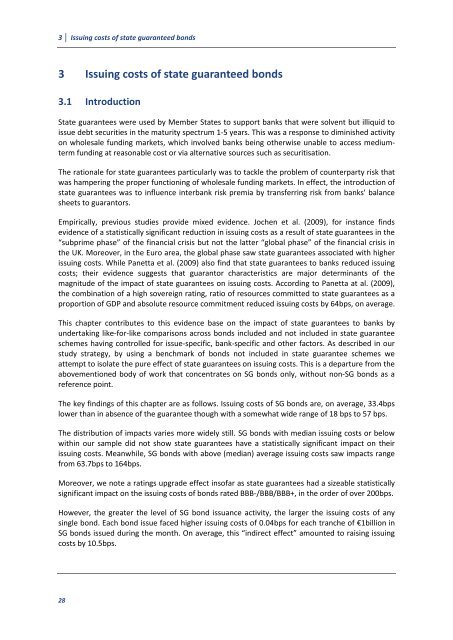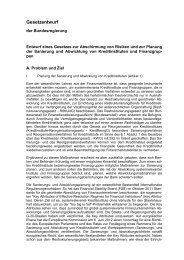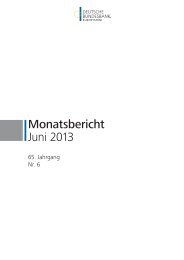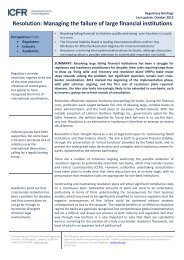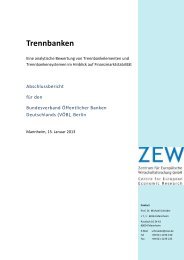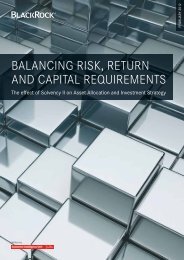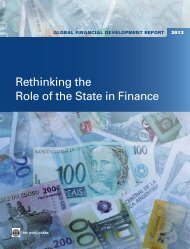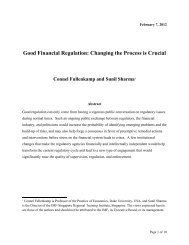3 Issuing costs of state guaranteed bonds - Financial Risk and ...
3 Issuing costs of state guaranteed bonds - Financial Risk and ...
3 Issuing costs of state guaranteed bonds - Financial Risk and ...
Create successful ePaper yourself
Turn your PDF publications into a flip-book with our unique Google optimized e-Paper software.
3 <strong>Issuing</strong> <strong>costs</strong> <strong>of</strong> <strong>state</strong> <strong>guaranteed</strong> <strong>bonds</strong><br />
3 <strong>Issuing</strong> <strong>costs</strong> <strong>of</strong> <strong>state</strong> <strong>guaranteed</strong> <strong>bonds</strong><br />
3.1 Introduction<br />
State guarantees were used by Member States to support banks that were solvent but illiquid to<br />
issue debt securities in the maturity spectrum 1-5 years. This was a response to diminished activity<br />
on wholesale funding markets, which involved banks being otherwise unable to access mediumterm<br />
funding at reasonable cost or via alternative sources such as securitisation.<br />
The rationale for <strong>state</strong> guarantees particularly was to tackle the problem <strong>of</strong> counterparty risk that<br />
was hampering the proper functioning <strong>of</strong> wholesale funding markets. In effect, the introduction <strong>of</strong><br />
<strong>state</strong> guarantees was to influence interbank risk premia by transferring risk from banks' balance<br />
sheets to guarantors.<br />
Empirically, previous studies provide mixed evidence. Jochen et al. (2009), for instance finds<br />
evidence <strong>of</strong> a statistically significant reduction in issuing <strong>costs</strong> as a result <strong>of</strong> <strong>state</strong> guarantees in the<br />
“subprime phase” <strong>of</strong> the financial crisis but not the latter “global phase” <strong>of</strong> the financial crisis in<br />
the UK. Moreover, in the Euro area, the global phase saw <strong>state</strong> guarantees associated with higher<br />
issuing <strong>costs</strong>. While Panetta et al. (2009) also find that <strong>state</strong> guarantees to banks reduced issuing<br />
<strong>costs</strong>; their evidence suggests that guarantor characteristics are major determinants <strong>of</strong> the<br />
magnitude <strong>of</strong> the impact <strong>of</strong> <strong>state</strong> guarantees on issuing <strong>costs</strong>. According to Panetta at al. (2009),<br />
the combination <strong>of</strong> a high sovereign rating, ratio <strong>of</strong> resources committed to <strong>state</strong> guarantees as a<br />
proportion <strong>of</strong> GDP <strong>and</strong> absolute resource commitment reduced issuing <strong>costs</strong> by 64bps, on average.<br />
This chapter contributes to this evidence base on the impact <strong>of</strong> <strong>state</strong> guarantees to banks by<br />
undertaking like-for-like comparisons across <strong>bonds</strong> included <strong>and</strong> not included in <strong>state</strong> guarantee<br />
schemes having controlled for issue-specific, bank-specific <strong>and</strong> other factors. As described in our<br />
study strategy, by using a benchmark <strong>of</strong> <strong>bonds</strong> not included in <strong>state</strong> guarantee schemes we<br />
attempt to isolate the pure effect <strong>of</strong> <strong>state</strong> guarantees on issuing <strong>costs</strong>. This is a departure from the<br />
abovementioned body <strong>of</strong> work that concentrates on SG <strong>bonds</strong> only, without non-SG <strong>bonds</strong> as a<br />
reference point.<br />
The key findings <strong>of</strong> this chapter are as follows. <strong>Issuing</strong> <strong>costs</strong> <strong>of</strong> SG <strong>bonds</strong> are, on average, 33.4bps<br />
lower than in absence <strong>of</strong> the guarantee though with a somewhat wide range <strong>of</strong> 18 bps to 57 bps.<br />
The distribution <strong>of</strong> impacts varies more widely still. SG <strong>bonds</strong> with median issuing <strong>costs</strong> or below<br />
within our sample did not show <strong>state</strong> guarantees have a statistically significant impact on their<br />
issuing <strong>costs</strong>. Meanwhile, SG <strong>bonds</strong> with above (median) average issuing <strong>costs</strong> saw impacts range<br />
from 63.7bps to 164bps.<br />
Moreover, we note a ratings upgrade effect ins<strong>of</strong>ar as <strong>state</strong> guarantees had a sizeable statistically<br />
significant impact on the issuing <strong>costs</strong> <strong>of</strong> <strong>bonds</strong> rated BBB-/BBB/BBB+, in the order <strong>of</strong> over 200bps.<br />
However, the greater the level <strong>of</strong> SG bond issuance activity, the larger the issuing <strong>costs</strong> <strong>of</strong> any<br />
single bond. Each bond issue faced higher issuing <strong>costs</strong> <strong>of</strong> 0.04bps for each tranche <strong>of</strong> €1billion in<br />
SG <strong>bonds</strong> issued during the month. On average, this “indirect effect” amounted to raising issuing<br />
<strong>costs</strong> by 10.5bps.<br />
28


